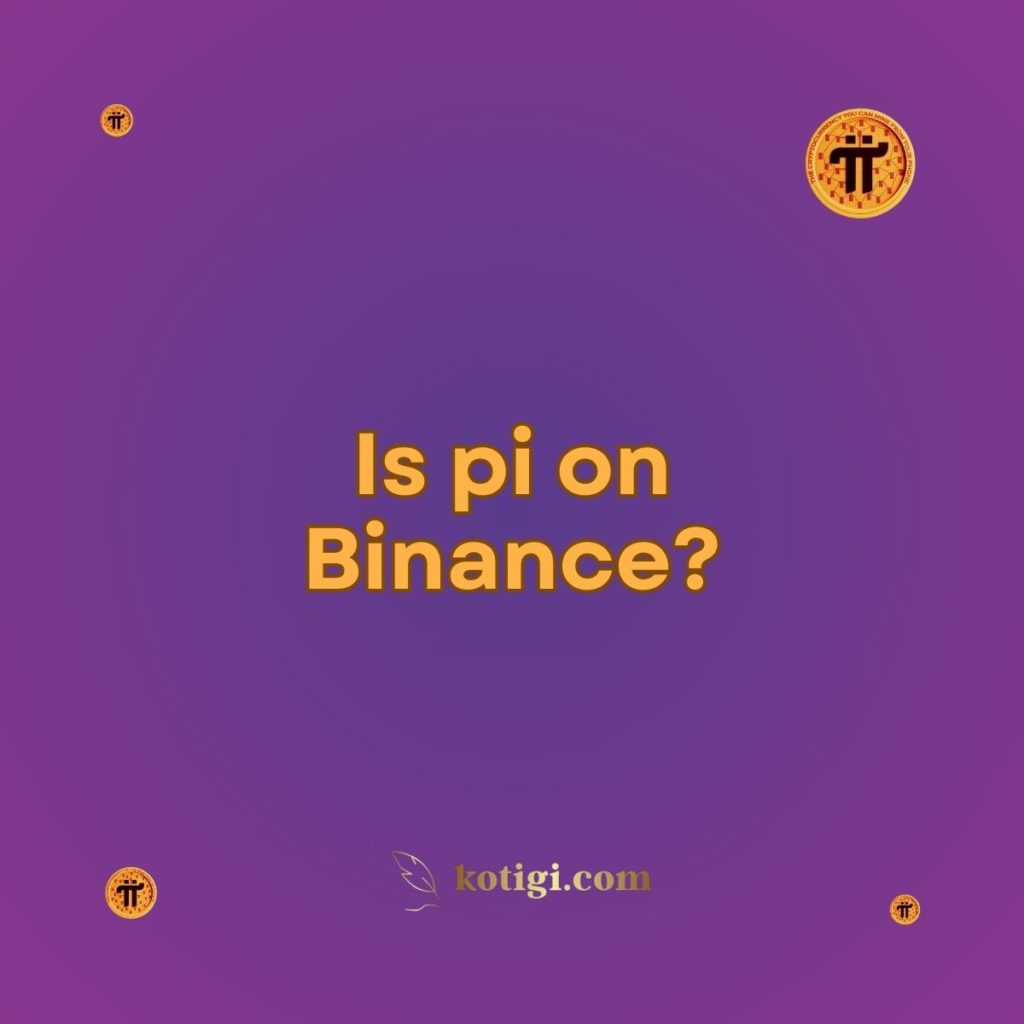
Is pi on Binance?
Currently, Pi Network is not listed on Binance or any other major cryptocurrency exchange. Pi is still in its enclosed Mainnet phase, meaning it is not yet available for public trading. However, once Pi transitions to its open Mainnet and meets certain criteria, there is a possibility that it could be listed on exchanges like Binance. Until then, users must wait for official announcements from Pi Network about its future availability on trading platforms.
Introduction
As the Pi Network community grows, many Pioneers are eager to know when Pi will be available on major cryptocurrency exchanges like Binance. Binance, one of the world’s leading crypto exchanges, is a sought-after platform for new cryptocurrency listings due to its large user base, liquidity, and credibility. However, at the time of writing, Pi is not listed on Binance or any other public exchange. This is primarily due to the fact that Pi Network is still in its enclosed Mainnet phase, which limits its availability for public trading.
In this article, we’ll explore the current status of Pi’s listing on exchanges like Binance, what needs to happen for Pi to become tradable, and what users can expect in the future.
Current Status of Pi Network
What Is the Enclosed Mainnet?
Pi Network is currently in what it calls the enclosed Mainnet phase. During this phase, the Pi blockchain is live and operational, but it is closed off from external networks and exchanges. This means that Pi coins, while being mined and transferred within the network, cannot yet be bought, sold, or traded on public platforms like Binance.
The purpose of the enclosed Mainnet is to allow Pi’s development team to refine the network’s security and functionality, while also giving users time to complete KYC (Know Your Customer) verification. Once the network transitions to the open Mainnet, Pi will be able to interact with external exchanges.
Why Isn’t Pi Listed on Binance Yet?
There are a few key reasons why Pi is not yet available on Binance:
- Open Mainnet Not Launched: For Pi to be listed on any public exchange, it must first transition to the open Mainnet, which will allow Pi coins to be freely traded on the market.
- Regulatory Compliance: Cryptocurrency exchanges like Binance typically require projects to meet certain regulatory and technical standards before listing. Pi Network is still in the process of rolling out KYC verification and ensuring its system complies with global regulations.
- Market Readiness: Pi needs to establish real-world use cases and a stable, scalable network before it can be listed on a major exchange. This involves building a robust ecosystem and ensuring that Pi coins have legitimate utility beyond speculative trading.
Will Pi Be Listed on Binance in the Future?
The Path to Listing on Binance
While there is no official announcement regarding Pi’s listing on Binance, it is possible that Pi will be listed on exchanges like Binance once certain milestones are met. Here’s what needs to happen for Pi to be eligible for trading on Binance:
- Open Mainnet Launch: The most crucial step is the launch of Pi’s open Mainnet. Until this happens, Pi will not be tradable on any public platform. The open Mainnet will enable Pi coins to be exchanged for other cryptocurrencies or fiat currencies.
- KYC Completion: Pi Network must complete the KYC verification process for its millions of users. Only verified users will be able to transfer their Pi coins and trade them on exchanges. Binance and other exchanges typically require strong identity verification measures to prevent fraud and ensure compliance with financial regulations.
- Exchange Partnerships: Pi’s development team will need to form partnerships with exchanges like Binance to facilitate its listing. This involves meeting the exchange’s listing requirements, including liquidity provisions, technical audits, and legal compliance.
- Community and Ecosystem Growth: Pi’s ecosystem must show that it has real-world utility, whether through decentralized applications (dApps) or partnerships with businesses. Binance often looks for projects that have strong communities and active development to ensure that the coin has long-term potential.
Binance Listing Criteria
Binance, as a leading exchange, follows strict criteria when evaluating whether to list a cryptocurrency. Some of the factors Binance considers include:
- Innovation and Technical Development: Binance prioritizes projects that bring innovation to the blockchain space. Pi’s unique approach to mobile mining and decentralization could work in its favor when applying for listing.
- User Base: Binance looks for projects with a large, engaged user base. With over 47 million pioneers, Pi Network has the community size that could attract attention from exchanges.
- Regulatory Compliance: Pi Network must ensure that its operations comply with the legal frameworks of various countries. Binance carefully evaluates the legal standing of projects to avoid regulatory risks.
- Market Demand: Binance considers the level of market demand and interest from its user base before listing a coin. If Pi generates enough demand from its community and the broader crypto market, it could increase the likelihood of a listing.
What Can Users Do in the Meantime?
Stay Informed About Pi’s Progress
The best thing Pi users can do right now is stay informed about the progress of the project. The Pi Network development team regularly provides updates through the app and social media channels, including information about the open Mainnet launch and any upcoming milestones. Monitoring these updates will give users a clearer picture of when Pi might become tradable on exchanges like Binance.
Complete KYC Verification
Pi users should prioritize completing their KYC verification process as soon as it becomes available to them. KYC is mandatory for all Pi users who wish to transfer or trade their coins once Pi is listed on exchanges. Completing this process now will ensure that you are ready to sell or trade your Pi when the open Mainnet is launched.
Prepare for Pi’s Open Mainnet
Although Pi cannot be sold or traded right now, users can prepare for the open Mainnet by:
- Setting up a Pi Wallet: Pi’s wallet allows users to store and transfer their coins securely within the Pi ecosystem. Once the open Mainnet is live, users will need a wallet to interact with exchanges and transfer Pi to external wallets.
- Learning about cryptocurrency trading: For those who are new to cryptocurrency, it might be helpful to learn the basics of how trading works, how to set up accounts on exchanges like Binance, and how to secure your assets using cold wallets or other security measures.
Risks and Considerations
Market Volatility
Once Pi becomes tradable on Binance or other exchanges, it will be subject to the same market volatility as other cryptocurrencies. Newly listed coins often experience price fluctuations due to high demand and speculative trading. It’s important for users to be aware of these risks and to avoid panic-selling or making impulsive decisions based on short-term price movements.
Potential Delays in Listing
Even after Pi’s open Mainnet launch, there may still be delays in its listing on exchanges like Binance. Listing applications can take time to process, and Pi Network must meet all of Binance’s technical and legal requirements before being approved. Users should manage their expectations and be prepared for potential delays.
Conclusion
At present, Pi is not listed on Binance or any other cryptocurrency exchange. The project is still in its enclosed Mainnet phase, meaning Pi coins cannot be traded, sold, or bought on public platforms. However, once Pi transitions to its open Mainnet and completes key steps such as KYC verification and ecosystem development, there is a possibility that Pi could be listed on Binance in the future.
While waiting for Pi to become tradable, users can take steps to prepare, such as completing KYC verification and staying informed about the project’s progress. Until Pi is officially listed, it’s important to manage expectations and be cautious of any speculative claims about its future listing or value.
Key Takeaways:
- Pi is not listed on Binance or any other exchange as of now.
- The open Mainnet launch is required before Pi can be traded on any platform.
- KYC verification is mandatory for users who want to transfer or trade Pi in the future.
- Pi must meet Binance’s listing criteria, including regulatory compliance, liquidity, and technical audits.
- Users should stay informed and be prepared for potential market volatility once Pi becomes tradable.





